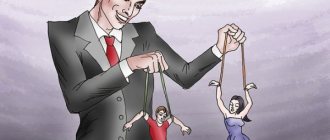Victimization is a concept that in some psychological modalities is interpreted as the process of becoming a victim. According to one of the founders of the doctrine of positivist victimology, B. Mendelssohn, the concept of “victim” is the opposite of the concept of “criminal”.
The very term “victim” and the theory that a person, unconsciously or consciously, by his behavior provokes a criminal to commit violent acts, causes a lot of controversy among psychologists.
What is victimization behavior
The concept of “victim behavior” is often used in criminal psychology. Specialists in this area consider the victim’s behavior from two points of view.
According to the first, a person who has suffered from violent acts provokes the rapist to commit a crime - attacks, threatens, beats, robs or commits other dangerous actions. According to the second version, the victim does not consciously provoke, but certain actions on her part make the rapist want to demonstrate aggression
.
As an illustration, we can consider the actions of a doctor who was unable to help a patient (due to an error or other reasons); this caused the patient or his relatives to want to take revenge on the specialist. If we consider this situation from the first point of view, then the patient plays the role of the victim. He chose a specialist who played the role of the rapist. The patient-victim at the treatment stage sees in the doctor a strong person who can be trusted and admires him. The victim herself, who finds herself in a similar situation, is characterized by low self-esteem, shy and timid. Often such a person shifts the blame for his mistakes and failures onto those around him, “fate”.
Adhering to the second interpretation, we consider the situation as follows. The specialist takes the position of a rapist - he conflicts, uses physical or other types of violence. When he meets a stronger opponent in the person of a relative of the patient, he himself enters into the role of the victim.
It also happens that a physically and psychologically very strong person chooses to play the role of a victim. He is forced to make such a choice by circumstances in which it is necessary to protect himself or loved ones from injustice, to defend his own principles. Such behavior is not considered pathological and is justified in a psychological sense.
Examples of victimization behavior
- When teenagers start doing something as a bet: who can jump from a certain height, who will drink more or steal a car. As a rule, such disputes end in disastrous events.
- If a girl walks home alone late at night in a short miniskirt through a seedy and unlit neighborhood.
- High school girls who start flirting with older men. This doesn't lead to anything good either.
- A person who brags or displays a large amount of money. Most likely, greedy people will become interested in it and will forcibly take away the funds.
Basic principles of victimization
The tendency to victimize is formed in childhood and consolidated in adolescence. One of the most important factors in the formation of victimization in children is the situation of physical and emotional violence in the family. A significant role is also played by the destructive influence on the psyche of adolescents from significant adults (relatives, teachers), and peers.
Under the influence of these factors, certain personal characteristics appear:
- increased anxiety, uncertainty and low self-esteem;
- emotional instability;
- the tendency to ignore one's own interests in favor of others.
Often, a “victim” with low self-esteem strives to prove his strength, rightness, and test his strength. This results in risky behavior (most often in adolescents).
In some cases, victimization is a concomitant of mental disorders. Problems of social adaptation of a pathological nature can result in a tendency to masochism and sadism, exhibitionism, and nymphomania. Similar manifestations of mental abnormalities can occur among victims of crimes (sometimes repeated with the same victim).
A person can also fall into the position of a victim if he:
- is in a subordinate position, he fulfills the demands of the aggressor, but very slowly, which “angers” the attacker even more;
- behaves provocatively or in his usual way, but the abuser views his behavior as offensive.
The fact that the aggressor in both these cases perceives the actions of the “victim” as offensive and unacceptable is solely his subjective opinion of the attacker. It is connected with the peculiarities of his perception and thinking.
Signs of victimization
- A person attracts criminals, manipulators and other ill-wishers;
- Such a person silently endures insults, sacrifices his interests;
- The person constantly experiences problems in relationships (other people quickly lose interest in him and take advantage of his kindness);
- He constantly finds himself in dangerous situations;
- Such people walk with hunched shoulders, hunched backs, dull eyes, lowered heads and move uncertainly;
- A person with victimized behavior has low self-esteem, increased anxiety and is emotionally unstable.
- The personality cannot stand up for itself, shows humility, and is very suggestible.
How does victimization manifest itself?
Victim behavior , according to some experts, is reflected in the fact that a person often finds himself in situations where he finds himself in the position of the victim. In criminal psychology, victimization is considered as the ability to “attract” and attract the attention of antisocial individuals - rapists, maniacs.
According to victimization theory, the victim behaves in a certain way. His behavior arouses increased interest and awakens the desire to show aggression in the criminal.
Victim behavior from a psychological point of view
According to supporters of the victimization theory, it is especially often demonstrated by adolescents who:
- very ambitious;
- tend to defend their point of view;
- maximalistic;
- have insufficient life experience.
All of these factors cause teenagers to often find themselves in unpleasant, and often dangerous, situations. It’s not the result they hoped to get that forces them to “go for a second round” and achieve their goal. This again turns into trouble.
Some people tend to conflict even when there are no objective reasons for a clash. But it is known that those who offend their peers direct aggression towards children and demonstrate special behavior. They do not enter into conflicts even if their personal interests are affected; they try to avoid confrontation and hide from troubles.
“Victims” are vulnerable, naive, and physically weaker than their offenders. The appearance of those who more often than others fall into the “victim” position also attracts attention. Teenagers often have an absent-minded look, a rustic expression on their faces, stoop, their gait is uncertain, mincing.
Here we cannot help but emphasize that legal experts and the vast majority of psychologists believe that such “signs of a victim” in no way justify the criminal and do not reduce the degree of his guilt for the violence committed.
Two types of victimization behavior
People who tend to exhibit victimized behavior can take the place not only of a potential victim, but also of a rapist. Therefore, there are 2 very different types of behavior.
Compromising or conforming - people take on the role of a victim, expect violent actions against them, deception, and insults. They show timidity, easily submit to the will of others, and often not only justify the behavior of their rapist, but also consider it correct. The reason for such “worship” of the aggressor is that the victim sees in him a stronger personality who is capable of committing actions that she herself does not dare to do.
People with a conformist position have low self-esteem; they are confident in their insignificance and inability to decide or be responsible for anything. They shift the blame for their failures onto external circumstances or other people, like to complain, and do not hide their position: “What about me? I'm just a victim."
Demonstrative or emotionally unstable behavior is typical for people who themselves show aggression and provoke others. The form of provocation can be open or implicit. This behavior manifests itself in bullying of the weaker and psychological violence.
Types of victimization
Victimization is a large complex of features that are considered as the cause of aggression and illegal actions. Researchers have identified several types of victimization.
Behavioral - manifests itself in the position “I am guilty” and “I am innocent.” A person who takes the position of an innocent person often provokes aggression towards himself and deliberately chooses dangerous situations. Being in the position of the innocent, he falls into it by accident, he does not provoke the aggressor in any way.
Based on the number of victims, mass and individual victimization are distinguished. With mass victimization, a large group of people (often of a certain nationality, with physical characteristics) suffers. In the case of individual victimization, there is only one victim.
Factors that give rise to a tendency towards victimization
It is believed that the victim’s victim behavior manifests itself against the background of mental disorders and personality traits. But there are other reasons that make a person behave like a victim.
Social factors
Stable self-esteem, the ability to defend one’s interests and boundaries are formed in the process of upbringing in a family. A person who grew up in a calm environment, felt complete acceptance and love from his parents, respect from adults for himself and for each other, even on a subconscious level, does not wish harm to himself. He has a well-developed instinct of self-preservation, which prevents victimization from appearing.
In order for the innate survival program inherent in each individual to fail, and for a person to become a victim, he must be influenced by very serious factors. They may be:
- peculiarities of upbringing in the family - frequent conflicts, drunkenness of parents or one of them, drug addiction, antisocial lifestyle, physical cruelty towards the child, psychological violence;
- the child’s lack of feeling that his parents love him, care for him, and treat him with warmth;
- excessive care from parents. Attempts to protect the child from any difficulties of life and external influences do not allow the personality to develop normally. As a result, a person grows up who does not know how to distinguish between good and bad, and to resist pressure and danger. A person who grew up in conditions of hyperprotection is infantile, does not know how to plan the future and foresee the result of his actions, and does not know the laws of society well;
- conflicts among peers (most often in adolescence);
- negative emotional experiences (participation in or observation of scenes of violence) in childhood;
- a feeling of insufficient attractiveness, inferiority, which appeared due to the reaction of others to personal characteristics.
The listed factors are associated with the aggressive, toxic environment in which a person grows. Such conditions form a subjective, deformed idea of oneself, one’s own place in society, and the significance of life.
Phenomenological factors
The unfavorable environment in which a child is raised often creates the basis for his victimization. He becomes a person unable to stand up for himself, he has a weak will to achieve what he wants and a tendency to rely on circumstances.
Experts believe that the foundation of future victimization is the child’s tendency to show aggression towards animals and other children. By offending others, weaker ones, and not receiving an adequate response to his actions, the child learns that violence is normal. He is ready for the fact that it can be directed against him.
Often aggression in children and adolescents arises not only due to the characteristics of family communication. The environment of peers, watching films and programs with scenes of violence, and computer games have a very great influence. But the main role in the formation of victimization is still assigned to social conditions. If in real life the child is not in a situation where violence is normalized, then he will be able to distinguish between the reality he sees on the screen and the real one.
Constantly being in a cruel environment makes not only a child, teenager, but also an adult less sensitive to violence against others and towards themselves. He is in a depressed emotional state, experiencing anxiety, constantly waiting for a catch or disaster.
Victimization, how to get rid of it.
Severe victimization is considered a deviation that requires treatment. Therapy for people exhibiting victimized behavior is carried out comprehensively. A person whose victim behavior was formed in childhood needs the help of a team of specialists - a psychologist, a psychotherapist (psychiatrist).
Medications prescribed by a specialist can reduce the intensity of depression, ease anxiety, and normalize sleep. All this provides a resource for further psychological and psychotherapeutic study of problematic topics.
The work of a psychotherapist or psychologist with a victimized client is aimed at:
- revision of the attitude towards the events of the past, the formation of a strong feeling that something that happened before does not affect the situation today;
- formation of a stable, positive self-perception, increasing the degree of self-esteem, developing a sense of independence;
- correction of views, attitudes, changes in behavior patterns, revision of the value system;
- developing the ability to understand your emotions and feelings, control, analyze thoughts and actions;
- developing the ability to adequately communicate with others, interact productively, and correctly assess the attitude of other people and their intentions.
All of the listed areas of psychological work are very important, but they must be complemented by the formation of an environmentally friendly, friendly environment in which a person lives. It is important to reconsider your immediate environment, stop communicating or minimize contact with people who make you feel fear and feelings of inferiority. It is necessary to direct energy to those activities in which you can get good results and achieve success. All this is not avoidance or an attempt to hide from danger, but necessary measures of mental hygiene.
Treatment of victimization
Treatment of a disease such as victimization can be carried out in several directions: with medications and with the help of psychotherapy.
There is no specific cure for this disorder, so the choice of drugs and psychotherapy approaches will depend on the causes and factors of the disorder.
Drug treatment
Can be done using the following groups of drugs:
- Tranquilizers. They produce an anti-anxiety effect, that is, they reduce the level of fear and anxiety. In addition, they have a muscle relaxant and hypnotic effect.
- Antidepressants. Aimed at restoring pathologically bad mood, reducing the severity of neuropsychic stress and anxiety by increasing the amount of serotonin in the blood, which is responsible for maintaining mood balance.
- Normotimics. Aimed at softening the “sharp edges of character”, stabilizing mood, as well as short temper, impulsiveness and irritability.
- Sedatives reduce emotional stress and cause calm. These remedies include: tinctures of mint, motherwort and valerian.
Psychotherapeutic treatment
This treatment can be carried out in the following directions:
- Rational-emotional treatment. The main task is to help the patient eliminate the approach to life that is aimed at destruction.
- Cognitive treatment. The main task is to correct ideas, attitudes and thoughts that lead to inappropriate and maladaptive behavior. For example, a patient may receive the following task: describe his feelings in a stressful situation, and fragmentarily identify conscious conditions that provoke the manifestation of negative attitudes. This method is called correction and recognition of involuntary thoughts.
- Behavioral treatment is aimed at developing and maintaining the skills of using adequate actions, sustainable self-control by changing unacceptable actions to acceptable ones, as well as using methods leading to the elimination of maladaptive behavior. For example, intensifying factors that cause anxiety, or the “flooding” method (a psychologist puts the patient in a frightening situation, helping to overcome it).
As part of psychotherapy, music therapy can also be used, the main task of which is to harmonize the soul and body, to balance the emotional state with the help of musical means. Art therapy is also used, the task of which is to harmonize a person’s mental state through the development of the ability of self-expression, as well as the achievement of peace and tranquility. That is, victim behavior is something that needs to be realized, understood and learned to control.
Prevention of victimization
It is possible to prevent the development of victim behavior in a child, adolescent, and later in an adult if the family, society, and law enforcement agencies are ready for this. Preventing violence is the main direction that contributes to the formation of a personality that knows how to protect its physical and psychological boundaries and has adequate self-esteem.
Ideally, preventive work should be carried out at several levels at once:
- family - developing in parents a high level of empathy, the ability to understand the psychological and physiological needs of children and satisfy them;
- identification of families where violence is used against children, work of psychologists, social workers and law enforcement officers with parents;
- creating a friendly, supportive and accepting environment in preschool institutions and schools;
- creating conditions in educational institutions for the psychological development of children, as well as for the environmentally friendly processing of their negative emotions (work with a psychologist, sports clubs, creative studios);
- teaching children and adolescents the rules of psychological and physical self-defense;
- clarification of the legal consequences of violent actions.
Another very important factor in preventing victimization is not blaming the victim for what happened to them and trying to shift responsibility for the violence from the perpetrator to the victim. The latter needs the support of the law enforcement system, family, and environment.
Irina Sherbul
Victimology
There is a science that studies such people. It's called victimology. Feminists actively oppose it. They believe that this science justifies violence by placing the victim in a conflict-prone position. Feminists have done their job, and Western criminology no longer has such a term.
However, in psychology the concept of victim behavior is quite well described. It is known to be predominantly mindless and can stem from subconscious impulses.
Victims, even subconscious ones, are betrayed by a victim complex and even a corresponding appearance.











